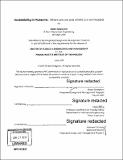Accessibility in museums : where are we and where are we headed
Author(s)
Shaligram, Shakti.
Download1119537602-MIT.pdf (7.696Mb)
Other Contributors
Massachusetts Institute of Technology. Engineering and Management Program.
System Design and Management Program.
Advisor
Maria Yang.
Terms of use
Metadata
Show full item recordAbstract
This study examines the experience of blind people in science and art museums. It is important for two reasons. First, museums have the potential to become hotbeds for the development of inclusive technology and practices. Second, improving the experience for a small section of society with special needs, blind visitors in this case, can lead to a better experience for everyone. In the current landscape, museums are already on this path consciously or unconsciously. At this juncture, the right decisions could lead to a better and more inclusive future for everyone. As a first step in this direction, this thesis describes the use of the human centered design process to identify opportunity areas that can improve the experience universally. The three key areas were identified through extensive primary and secondary research involving interviews with key stakeholders and user observation. Major opportunities lie in the areas of Navigation, Multimodal experiences and Social Inclusion. These areas not only represent challenges faced by blind visitors, but also key improvement areas for all visitors. For example, navigation is important for all visitors, but more so for blind visitors because it represents independence. Current layouts of museums force otherwise completely independent visitors to depend on external help. Improvements in any of these areas is very likely to improve the overall experience of museums, while including an often overlooked segment of the population.
Description
Thesis: S.M. in Engineering and Management, Massachusetts Institute of Technology, System Design and Management Program, 2019 Cataloged from PDF version of thesis. Includes bibliographical references (pages 61-66).
Date issued
2019Department
Massachusetts Institute of Technology. Engineering and Management ProgramPublisher
Massachusetts Institute of Technology
Keywords
Engineering and Management Program., System Design and Management Program.